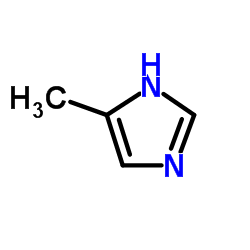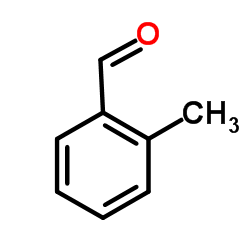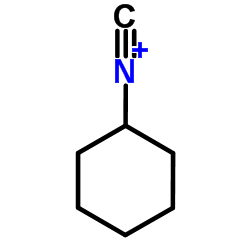AGI-5198

AGI-5198 structure
|
Common Name | AGI-5198 | ||
|---|---|---|---|---|
| CAS Number | 1355326-35-0 | Molecular Weight | 462.559 | |
| Density | 1.2±0.1 g/cm3 | Boiling Point | 707.6±60.0 °C at 760 mmHg | |
| Molecular Formula | C27H31FN4O2 | Melting Point | N/A | |
| MSDS | Chinese USA | Flash Point | 381.7±32.9 °C | |
| Symbol |

GHS06 |
Signal Word | Danger | |
Use of AGI-5198AGI-5198 is a potent and selective mutant IDH1R132H inhibitor with an IC50 of 0.07 μM. |
| Name | N-cyclohexyl-2-(3-fluoro-N-[2-(2-methylimidazol-1-yl)acetyl]anilino)-2-(2-methylphenyl)acetamide |
|---|---|
| Synonym | More Synonyms |
| Description | AGI-5198 is a potent and selective mutant IDH1R132H inhibitor with an IC50 of 0.07 μM. |
|---|---|
| Related Catalog | |
| In Vitro | Measurements of R-2HG concentrations in pellets of TS603 glioma cells demonstrates dose-dependent inhibition of the mutant IDH1 enzyme by AGI-5198. AGI-5198 does not impair colony formation of two patient-derived glioma lines that express only the wild-type IDH1 allele (TS676 and TS516)[1]. Cancer cells heterozygous for the IDH1(R132H) mutation exhibits less IDH-mediated production of NADPH, such that after exposure to ionizing radiation (IR), there are higher levels of reactive oxygen species, DNA double-strand breaks, and cell death compared with IDH1 wild-type cells. These effects are reversed by the IDH1(R132H) inhibitor AGI-5198[2]. |
| In Vivo | AGI-5198 (450 mg/kg, p.o.) causes 50 to 60% growth inhibition of the tumor growth from human glioma xenografts. Tumors from AGI-5198- treated mice show reduced staining with an antibody against the Ki-67 protein. AGI-5198 does not affect the growth of IDH1 wild-type glioma xenografts[1]. |
| Kinase Assay | Inhibitory potency against the IDH2 R140Q and IDH2 R172K enzymes is determined in an endpoint assay in which the amount of NADPH remaining at the end of the reaction is measured by the addition of a large excess of diaphorase and resazurin. IDH2 R140Q is diluted to 0.25 μg/mL in 40 μL 1X Assay Buffer (150 mM NaCl, 50 mM potassium phosphate pH 7.5, 10 mM MgCl2, 10% glycerol, 2 mM B-ME, 0.03% BSA) and incubated for 16 hours at 25°C in the presence of 1 μL of compound in DMSO. The reaction is started with the addition of 10 μL of Substrate Mix (20 μM NADPH, 8 μM alpha-ketoglutarate, in 1X Assay Buffer) and incubated for 1 hour at 25°C. Then, remaining NADPH is measured by the addition of 25 μL of Detection Mix (36 μg/mL diaphorase, 18 μM resazurin in 1X Assay buffer), incubated for 5 minutes at 25°C, and read as described above. IDH2 R172K is assayed as for IDH2 R140Q with the following modifications: 1.25 μg/mL of protein is used, the Substrate Mix contained 50 μM NADPH and 6.4 μM alpha-ketoglutarate, and the compound is incubated for 1 hour before starting the reaction. |
| Cell Assay | TS603 cells are grown in medium containing either AGI-5198 (1.5μM) or DMSO vehicle control. One week prior to harvest cells are ransferred to differentiation medium (DMEM F12; 15 mM HEPES; 0.06% glucose; B27 without vitamin A; N2; Insulin/transferrin; 1% FBS) containing freshly added retinoic acid (1μM). ChIP of non-crosslinked cells is then carried out using established ChIP methods. 350 μg of lysate is immunoprecipitated-using anti-H3K9Me3, H3K27me3 or Rabbit Control IgG. After washing, ChIP DNA is eluted from protein G beads and analyzed by RT-PCR using SYBR green. Relative occupancy is calculated using the standard curve method and fold enrichment versus IgG. Enrichment in AGI- 5198-treated cells is normalized to vehicle control. Means and standard deviation are calculated from 4 technical replicates. |
| Animal Admin | SCID mice are injected subcutaneously with 106 glioma cells, which are suspended in 100 μL of a 50:50 mixture of growth media and Matrigel. Once tumors have reached a measurable size, mice are randomized into the indicated treatment groups. |
| References |
| Density | 1.2±0.1 g/cm3 |
|---|---|
| Boiling Point | 707.6±60.0 °C at 760 mmHg |
| Molecular Formula | C27H31FN4O2 |
| Molecular Weight | 462.559 |
| Flash Point | 381.7±32.9 °C |
| Exact Mass | 462.243103 |
| PSA | 67.23000 |
| LogP | 4.05 |
| Appearance of Characters | white to beige |
| Vapour Pressure | 0.0±2.3 mmHg at 25°C |
| Index of Refraction | 1.613 |
| Storage condition | 2-8°C |
| Water Solubility | DMSO: soluble3mg/mL, clear |
|
~42% 
AGI-5198 CAS#:1355326-35-0 |
| Literature: ACS Medicinal Chemistry Letters, , vol. 3, # 10 p. 850 - 855 |
|
~% 
AGI-5198 CAS#:1355326-35-0 |
| Literature: ACS Medicinal Chemistry Letters, , vol. 3, # 10 p. 850 - 855 |
|
~% 
AGI-5198 CAS#:1355326-35-0 |
| Literature: ACS Medicinal Chemistry Letters, , vol. 3, # 10 p. 850 - 855 |
|
~% 
AGI-5198 CAS#:1355326-35-0 |
| Literature: ACS Medicinal Chemistry Letters, , vol. 3, # 10 p. 850 - 855 |
| N-[2-(Cyclohexylamino)-1-(2-methylphenyl)-2-oxoethyl]-N-(3-fluorophenyl)-2-(2-methyl-1H-imidazol-1-yl)acetamide |
| cs-1429 |
| 1H-Imidazole-1-acetamide, N-[2-(cyclohexylamino)-1-(2-methylphenyl)-2-oxoethyl]-N-(3-fluorophenyl)-2-methyl- |
| agi-5198||agi5198|agi 5198|idh c35 |
| qcr-214 |
| agi5198 |
| AGI-5198 |

![2-[(2-chloro-acetyl)-(3-fluoro-phenyl)-amino]-N-cyclohexyl-2-o-tolyl-acetamide structure](https://image.chemsrc.com/caspic/291/1355324-97-8.png)


